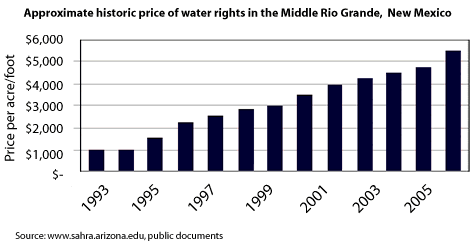 If legendary oil investor T. Boone Pickens is as successful investing in the water industry as he was investing in oil, it may pay to follow his lead. I’ve written on more than one occasion here about the potential for investing in water companies in the next few years along with several others. Chris Mayer of Daily Wealth recently wrote the following article about the emerging demand, shrinking supply of usable water and the profit potential of investing in water rights.
If legendary oil investor T. Boone Pickens is as successful investing in the water industry as he was investing in oil, it may pay to follow his lead. I’ve written on more than one occasion here about the potential for investing in water companies in the next few years along with several others. Chris Mayer of Daily Wealth recently wrote the following article about the emerging demand, shrinking supply of usable water and the profit potential of investing in water rights.
A Refreshing Idea
By Chris Mayer
He’s a member of the coveted Forbes 400 with an estimated net worth of over $2.7 billion. The Oklahoma native built a fortune on buried treasure – namely, oil and gas. He is the founder of Mesa Petroleum, which he started for $2,500. In its first year, it netted $435,000 in profits and eventually became a billion-dollar enterprise. He was also involved in a bunch of hostile takeovers of oil and gas companies – Gulf, Phillips, and Unocal.
Now 78, the old billionaire has a new buried treasure he’s accumulating – water rights.
Do you have a guess who this cagey guy is?
He’s T. Boone Pickens. Yes, that T. Boone Pickens. And he’s gobbling up water rights in Texas.
Pickens’ new company, Mesa Water, has been buying up ground water rights in Roberts County, Texas – 200,000 acres in all. He says that over a 30-year period, he expects to make more than $1 billion on his investment of $75 million. (Which means he’ll be able to buy himself a very nice present for his 108th birthday!)
Pickens wants to take the water from the Ogallala Aquifer and pump about 200,000 acre feet of groundwater annually to El Paso, Lubbock, San Antonio, or Dallas-Fort Worth – for a price, of course.
This price would depend on how far the water needs to go. El Paso would pay around $1,400 per acre foot, while Dallas would pay $800 and San Antonio more than $1,000.
Acre feet, by the way, is a common industry metric. Basically, an acre foot of water is the amount of water required to flood a plain of 1 acre to a depth of 1 foot. Generally speaking, 1 acre foot of water can support two families of four for one year.
Pickens has no qualms about charging people for water and has a ready quip for those who think it wrong to do so. “I know what people say – water’s a lot like air. Do you charge for air? ’Course not; you shouldn’t charge for water,” says he. “Well, OK, watch what happens. You won’t have any water.”
Of course, Pickens is right. Many others are coming to the realization that water is too cheap. Hence, water rights are a great buy today.
As an individual investor, you can’t trade water rights very easily. But you can invest in a company that owns almost as much water as Pickens does – and actually, the acre feet that this company owns are more valuable than what Pickens bought. MUCH more valuable…
I’m talking about PICO Holdings (PICO).
The Rio Grande isn’t as grande as it used to be, and the Colorado River now turns to dust before reaching the Gulf of California. The once-plentiful sources of water in the American West aren’t as plentiful as they used to be. So it’s little wonder that water rights are becoming a hot commodity.
I think the value of water rights in the West will continue to soar, which is why I’m fond of PICO Holdings (PICO). The company owns 134,130 acre feet of water rights in Nevada and Arizona, plus a small amount in Colorado. In the pipeline, so to speak, the company seeks approval for an additional 42,800 acre feet of water in its Nevada lands. The company is constantly looking to acquire new water rights. It does this by legally establishing water rights in property it already owns, or by purchasing outright already established legal water rights.
Of all the places to own water rights in this country, you could choose no better than Nevada and Arizona. That’s because these states have among the highest population growth rates in the country and, subsequently, also have among the highest new home construction – both are incredibly bullish for the value of water rights.
To give you some idea of the value, let’s look at recent transactions. Keep in mind, though, that like other types of real estate, these numbers are not comparable across the board. In other words, water rights closer to end-users are worth more than water rights that are far away. Also, senior water rights are the most valuable kind. In some cases, there are several water rights on the same water resource. In these cases, the most senior right is the most valuable – because in the event of drought, it’s the last water right to go.
With those caveats in mind, let’s look at a couple of transactions. In Nevada, Vidler and Lincoln County made a sale for 2,100 acre feet of water for a price of $7,500 per acre in October 2005. In Coyote Springs, also in Nevada, water rights sold for $6,050. In Arizona, Harquahala Valley water rights sold for $2,200 per acre foot.
That gives you a sense for the range. How high can prices go? Well, over the next few years, I wouldn’‘t be surprised to see water rights climb to $10,000 per acre foot in the arid states of Nevada, Arizona, and New Mexico.

But before getting too far ahead of ourselves, let’s take a look at PICO’s current value. Assuming a value of $3,500 per acre foot for its water rights, times 134,130 acre feet, you get about $469 million, which is greater than PICO’s current enterprise value. But this figure does not include the 42,800 acre feet in Nevada that PICO expects to obtain.
Another point I should make is that PICO also owns a storage facility capable of storing up to 1 million acre feet of water. Currently, the company is buying water and storing it. The company has stored the equivalent of about 90,000 acre feet of water. I haven’t counted any of this, which could bolster the valuation even further.
And of course, I haven’t said anything about its investment portfolio or land and other interests. But you can see the margin of safety in this stock.
Now let’s go back to those water rights for a minute. Based only on PICO’s existing water rights of 134,130 (and ignoring any rights that it expects to obtain), every $119 per acre/foot increase in the value of its holdings would add $1 per share to the value of PICO stock.
So if you start to play around with projections and make some upward adjustments on the value of water rights over the years – well, you can really get some ridiculous numbers. At $10,000 per acre foot, for example, PICO’s existing water rights would be worth $84 a share!
T. Boone Pickens thinks he’ll earn $1 billion on his $76 million investment – or basically 13 times his money. PICO – already in this business, with substantial expertise and a portfolio of more valuable water rights – could do even better.
—————————————————
Looking at the chart of PICO, it looks like water rights investing is crossing the radar of more investors. The stock recently broke out from a one and a half year base to a new all time high. The break out was accompanied by very good volume, indcating good momentum and strong potential for future gains in the relative short term. However, I’m sure the positive Daily Wealth article had something to do with the recent surge. This is a thinly traded stock and prone to big movements following an article from a popular newsletter like Daily Wealth. What I’d do is look for the stock to digest these gains a bit and return closer to 36 – 37 before considering a position.
 If legendary oil investor T. Boone Pickens is as successful investing in the water industry as he was investing in oil, it may pay to follow his lead. I’ve written on more than one occasion here about the potential for investing in water companies in the next few years along with several others. Chris Mayer of
If legendary oil investor T. Boone Pickens is as successful investing in the water industry as he was investing in oil, it may pay to follow his lead. I’ve written on more than one occasion here about the potential for investing in water companies in the next few years along with several others. Chris Mayer of 
.jpg) Afer a couple weeks of light holiday trading, the first trading week of the new year brought in volatility and a shift from commodities to tech as any oil, gold, silver and steel got hit hard. To close out the week, downgrades in Motorola, Exxon and Dell fueled significant selling on Friday, but not heavy enough to indicate institutional selling. There is enough downward momentum however to set up a test of key support levels this week- Nasdaq 2400, S&P 1400, Dow 12300 (the 50 day moving averages). The Nasdaq remains the strongest of the two and managed to close in the upper half of its range on Friday. With commodities getting hammered, The Dow and S&P were hit the hardest. In a check of leading stocks Friday, they were hit fairly hard and remain on shaky ground. The Self Investors Leading Stock Index fell 1.33% with volume 21% greater than the average. With big gains in hand over the past several months and the market looking tired up at these levels, now is certainly not the time to get aggressive on either side of the market. The economic calendar is light for the coming week and earnings won’t kick off in full force for another couple weeks. Expect more volatile days ahead as the market bounces around key support.
Afer a couple weeks of light holiday trading, the first trading week of the new year brought in volatility and a shift from commodities to tech as any oil, gold, silver and steel got hit hard. To close out the week, downgrades in Motorola, Exxon and Dell fueled significant selling on Friday, but not heavy enough to indicate institutional selling. There is enough downward momentum however to set up a test of key support levels this week- Nasdaq 2400, S&P 1400, Dow 12300 (the 50 day moving averages). The Nasdaq remains the strongest of the two and managed to close in the upper half of its range on Friday. With commodities getting hammered, The Dow and S&P were hit the hardest. In a check of leading stocks Friday, they were hit fairly hard and remain on shaky ground. The Self Investors Leading Stock Index fell 1.33% with volume 21% greater than the average. With big gains in hand over the past several months and the market looking tired up at these levels, now is certainly not the time to get aggressive on either side of the market. The economic calendar is light for the coming week and earnings won’t kick off in full force for another couple weeks. Expect more volatile days ahead as the market bounces around key support.